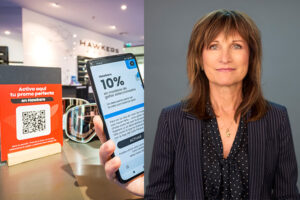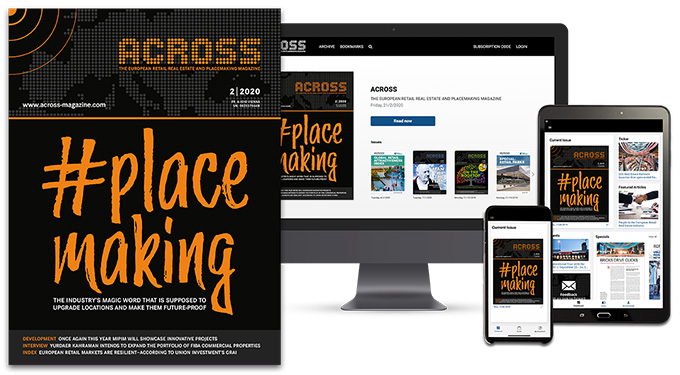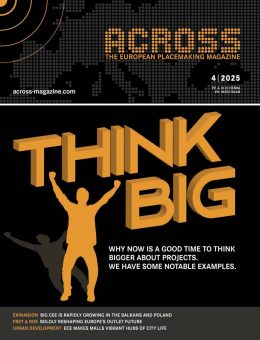ACROSS: You live and work in Silicon Valley. How significant is the technological discrepancy between what you experience daily around you and the reality at shopping centers?
David Blumenfeld: Without a question, I live in a technology bubble. Self-driving cars drive through my neighborhood, and this is where most of the tech companies’ beta tests take place. We see new technologies every day and everywhere. However – and this is where it gets exciting – this does not necessarily apply to the shopping center sector. Even here in the Bay Area, most malls are not particularly technology-oriented. Of course, a few examples of the use of technology in the shopping center sector stand out – but overall, the shopping centers here are not notably different from those in the rest of the USA.
ACROSS: Is there a difference compared to Europe?
Blumenfeld: Europe is very diverse in that respect. The United Kingdom has always been very progressive in terms of retail technology. During my time at Westfield, especially in London, we drove super innovative and exciting projects. At the same time, we talked to our industry colleagues from other countries, and they were just starting to outline roadmaps or set up basic websites. My experience with Europe, in general, is that when it comes to technology in the shopping center sector, there is a lot of testing, but the results are mixed. The United Kingdom, France, and Germany are probably the leading nations, but innovation is happening everywhere.
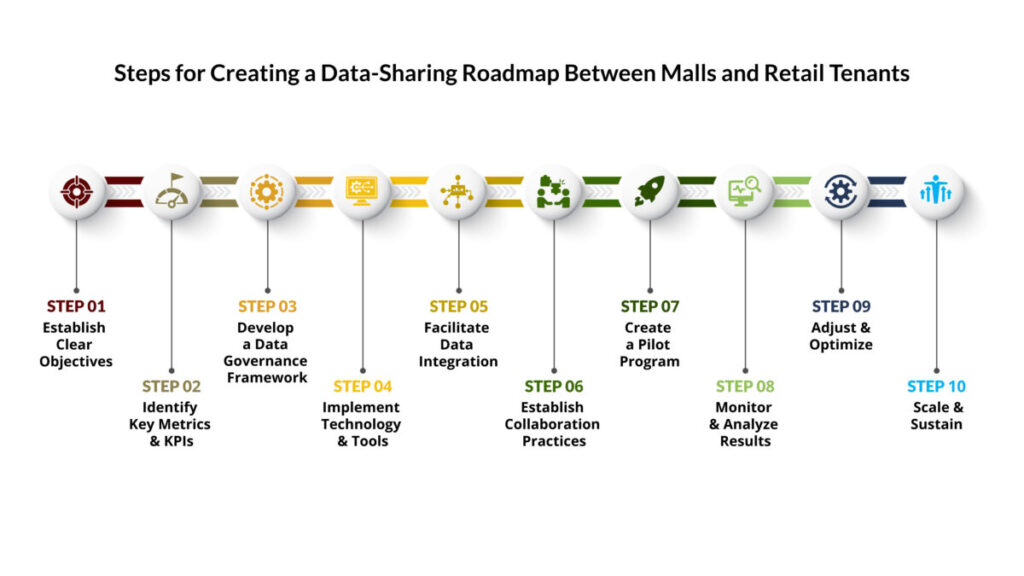
ACROSS: Your company focuses on integrating digital processes at shopping centers. Where do you see the greatest need?
Blumenfeld: About 10 years ago, everyone started to try to figure out what the customer’s experience should look like and stand out. Locations started to implement digital signage and digital advertising. In addition, of course, there were websites and apps, some of which were consciously used and others very deliberately not implemented. Either way, companies have created a certain digital foundation. Now, the focus is on topics that are rather unsexy for consumers. It’s about building operations, leasing, tenant management, and tenant communication. Data exchange plays a fundamental role here. So, the focus is not on the consumer but on how companies can take advantage of things like building management systems, thereby increasing the efficiency of their buildings.
ACROSS: What are the specific things that interest your customers?
Blumenfeld: One important point is that they must comply with all the GDPR rules and get the data protection perspective right. Furthermore, many clients are curious about people tracking and understanding how people move around. The traditional counting of people walking through the door has been around for a long time. However, people want to determine where customers are and how they get from the public area to the stores. This opens up a lot of opportunities not only for the design of the center but also for the tenant-landlord relationship. If a landlord can see that 10% of the people who walk past a particular store go there, he can take a completely different approach to the tenant if the latter complains about a lack of sales. It’s much easier to see if there are problems with customer flow or issues with the products or services on offer. Conversations about actual data lead to essential insights into leasing.
ACROSS: But, such insights can also have a negative impact.
Blumenfeld: Of course, but at least where the problems are becomes clear. If we stick with the example of declining sales at a store, it becomes clear where the primary responsibility lies in terms of overall traffic being driven to the store or something happening inside the store. Many in the shopping center industry tend to lean into the principle of “what I can’t measure, I don’t have to take into account” regarding data. However, I am firmly convinced that all industry players must get involved in data sharing, regardless of whether it brings them advantages or disadvantages in the short term.
ACROSS: In another interview, you mentioned that the biggest challenge regarding data sharing is getting retailers to cooperate and share data and technology. What are the concerns?
Blumenfeld: Landlords rent out space and try to maximize turnover. Retailers try to maximize sales and pay as little as possible for space. This situation automatically creates a conflict of interest. For landlords, it would be ideal if they could understand retailers’ sales data in real-time and not just based on sales reports at the end of each month. Tenants don’t want to immediately show increased sales, because they fear a rent increase. Generally speaking, tenants do not want landlords to be involved in their business. They want to decide for themselves how they run their businesses.
ACROSS: There is an understandable concern about transparency. However, this transparency already exists in the retail sector, namely in e-commerce.
Blumenfeld: Open data sharing between tenants and landlords provides the overall data we know from the online sector. Online retailers can track every time someone visits the website, where they click, what motivates them to stay on the website, and finally, what products they buy and when they return. This transparency can only be achieved offline if tenants and landlords share their data. The technology to do exactly that is there. So much data can be collected, obviously not broken down to the individual, but on a much more aggregated basis that explains the true purchase motivations and purchase impulses. From a mall perspective, understanding that purchase funnel dramatically improves the ability to market more efficiently.
ACROSS: What is a concrete example in which the relationship between tenant and landlord is significantly improved through data sharing?
Blumenfeld: The marketing fund, in particular, is a sticking point in the relationship between tenants and landlords at many shopping centers. This is where data delivers the most important arguments for spending money wisely. Another example is the operational benefit. Let’s take the example of a restroom located next to a food court that is cleaned every three hours based on an estimated number of 500 people using the restroom during that time. If you have camera-based technology that can more accurately track actual usage, you can set an automated trigger when those 500 visits are reached and send out a cleaning team. It’s a basic example, but one that demonstrates a more efficient use of resources that also improves the visitor experience.
ACROSS: One example in Europe in which tenants and landlords are already working closely together and exchanging data is the outlet sector.
Blumenfeld: Outlets follow a different business model. Turnover-based rents and data sharing are often part of the leasing contract. Therefore, tenants and landlords act in the same ecosystem. If the retailer wins, the landlord wins, and vice versa. Generally speaking, the more data that can be shared, the smarter the decisions will be. Of course, historical data has its value, and many smart decisions can be made without data. However, companies will benefit if they have the information and can act on it in real-time. Data sharing, however, is a question of a certain mindset.
ACROSS: What does that mean?
Blumenfeld: Both parties must be open to it and recognize the benefits that result from it. That was also the case 10 to 15 years ago. Shopping center operators can create so much high-quality data when a customer enters a store that it is comparable to the online equivalent. The question now is how that data should be used. Some operators use it primarily for their leasing teams and share the data with the tenants. Others take the approach of charging the tenants for this data. The latter approach is very risky for the relationship until the data has been validated over time. This is the only way to persuade the retailer to share more data and use the shared data effectively.
ACROSS: It sounds like the landlord has more responsibility regarding data sharing, especially at the beginning.
Blumenfeld: It’s more about a fair value exchange. The retailer must also show that it wants to be transparent. The example of e-commerce returns is often used. Retailers offering something like click-and-collect at their stores is the last step in fulfilling an e-commerce order. Most lease agreement clauses do not consider these types of sales; therefore, most retailers do not count them in their sales, especially if they have some kind of percentage lease agreement. On the other hand, if an e-commerce purchase is returned in the store, they are happy to deduct that return from their sales figures. This may be technically permissible due to vague or legacy contract language, but it doesn’t reflect the spirit of the partnership. For efficient data sharing, an honest and good lease relationship is essential.
ACROSS: Is there a roadmap when it comes to creating a perfect data exchange model?
Blumenfeld: As I explained, it starts with malls being willing to share more data, even if retailers are initially hesitant. So, it has to begin with center managers making the initial investment. Unfortunately, that step takes time because nothing happens quickly in the mall industry, especially when there’s a bit of a leap of faith in order to prove the ROI. Ultimately, data sharing is a mindset shift. By providing the initial data and explaining the opportunities that can be gained from it, the landlord can have a data-driven conversation with a tenant about their leasing relationship. Ideally, once data is shared and additional trust is built, tenants get to the point of actually sharing data in return.
ACROSS: That’s when the actual data sharing starts.
Blumenfeld: Yes, that’s the roadmap, but it doesn’t happen overnight. Mall owners are savvy business owners. The core of their business is to monetize everything they do. However, when it comes to data, they must learn to give to get. The first step is an investment in what you’re not getting back. The most crucial point in that discussion is establishing trust in the relationship. Data exchange in the shopping center industry is in its infancy. Everyone is talking about it, but if we look at examples, it rarely goes beyond data from tracking tools or communication platforms between tenants and landlords. However, the opportunity to make progress here is great.
ACROSS: In terms of data sharing: Do any key performance indicators already exist?
Blumenfeld: It depends on what you’re trying to do. If we think about today’s data exchange platforms, which are primarily used for monthly sales reports, tenant communications, and work orders, the simple KPI is whether all of a mall’s retailers are participating in the platform. Are they using it – whether from a communications perspective or a sales reporting perspective? When we look at tracking information, for example, can you confidently confirm that 90-95% of traffic was captured? Then comes the question of deeper information, such as the conversion rates of people who walked from the common areas into stores. As discussed in the previous example, if processes have been implemented that feed into the building management system, the questions are different. There is a whole range of operational metrics that can be mapped.
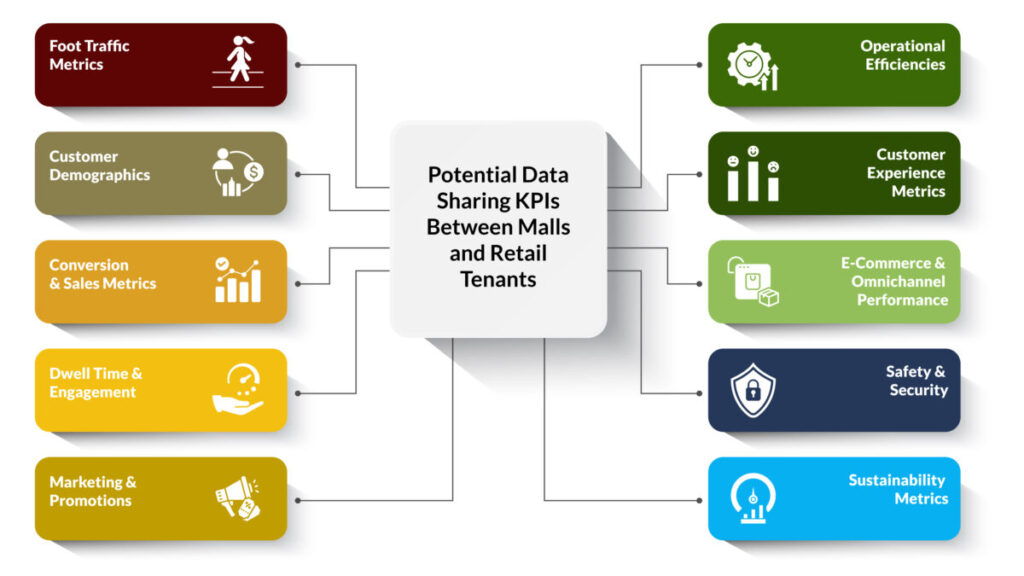
ACROSS: Ten years from now, what data sharing tools might be in use?
Blumenfeld: The industry will undoubtedly have a range of technological solutions in 10 years. However, this is of secondary importance. In the upcoming years, it will be more about creating awareness and trust on one side and improving and further developing existing solutions on the other. The most remarkable progress will be making data usable, which requires optimization. In the world of technology, perfect products never come onto the market; they are developed while used.
ACROSS: Will there be any effects on the retailer side within the next 10 years?
Blumenfeld: They will better understand their sales, inventory, merchandising, and customer patterns, and they will be better able to connect the dots. And, of course, whoever gets into data sharing will set themselves up for better sales. Nevertheless, establishing an accurate data-sharing model between tenants and landlords will take years, but if we start now, building the initial trust to exchange the first data sets can be done within a year. In parallel, AI and machine learning will speed up the processes as well.
ACROSS: Are there enough experts on the shopping center side who understand and can tackle the issue?
Blumenfeld: Most shopping center companies lack proptech experts. When we worked for Westfield, we invested in Westfield Labs, and at its peak, we had 70 employees, which was far more than any of its peers at the time. Even today, most shopping centers have one person who is dedicated to digital transformation. In reality, instead of hiring or outsourcing the work to dedicated experts, the marketing and/or IT departments end up being responsible for these initiatives. It’s not that these people aren’t intelligent or capable, but it’s just not their area of expertise, and they have their “day jobs” to do as well. “Data” is not a side project – it has to be a core issue. By and large, people understand the need, but help from outside is necessary in the vast majority of cases.
ACROSS: What are the general standards for data sharing?
Blumenfeld: There’s no standard as of yet. There is a lot of competition between the companies trying to set the standard. However, a standard is unnecessary for a landlord to invest in data sharing today. The technology is there, and the data can be generated now. While landlords are generally risk-averse when it comes to making investments that don’t immediately generate a tangible ROI, at a certain point, they have to make the leap. The good news is that they’re not alone. There are many companies, like NextRivet, that can provide hands-on expertise to prioritize the roadmap, select the right vendors, and get these projects off the ground.

David Blumenfeld is Co-founder of NextRivet.
NextRivet is a consulting firm focused on digital innovation and implementation for shopping centers and mixed-use real estate. With a commitment to delivering hands-on, practical solutions, NextRivet helps clients achieve measurable results through expertise in technology implementation, operational efficiency, and customer experience optimization.



